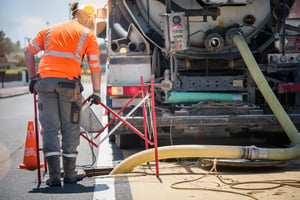 Sewer cleaning removes unwanted materials, such as non-biodegradable debris or grease and sludge build-up, from a pipe. Most sewer cleanings occur as part of a routine maintenance program, though cleaners also respond to emergency callouts for overflowing or damaged lines.
Sewer cleaning removes unwanted materials, such as non-biodegradable debris or grease and sludge build-up, from a pipe. Most sewer cleanings occur as part of a routine maintenance program, though cleaners also respond to emergency callouts for overflowing or damaged lines.
Most sewers in the United States are maintained by local utility companies, though property owners are usually responsible for lateral connections. These companies may have in-house crews in charge of cleaning, or they may hire qualified contractors to handle the job. This decision is usually guided by factors like labor and equipment availability and budget.
Routinely cleaning sewer systems can prevent blockages, clogged sewers, overflows and costly repairs. Small debris and grease buildup can turn into big problems down the road if lines are not regularly cleared and inspected, as can poorly installed or damaged pipes. On average, sewer cleaning and inspection should occur every 18-22 months. When deciding how often to clean a line, experts consider the age of the sewer system, the season, the location of the line, the pipe diameter, and the impact of vibrations or tremors from nearby roadways. These stressors have ongoing consequences for a sewer’s condition, so it’s important to have a maintenance plan in place to check for unwanted materials and pipeline deterioration.
Sewer Cleaning Procedures
So how do you clean a sewer line? Sewer operators deploy several different methods to clean sewers.
Hydraulic Sewer Cleaning Methods
Hydraulic cleaning methods include equipment that uses water and water velocity to clean the invert and walls of the sewer pipe, according to the EPA.
Hydro jetting, or jetting, uses water and pressurized air to push out debris and break down clogs. Jetters are high-efficiency machines and the most common solution used today for cleaning sewers. They propel spray through a hose and out a specialized rotating nozzle to clean and break-up debris. Water jetting is a safe, chemical-free process that does not damage pipes.
The jetting process can be customized in several ways for increased efficiency. Specialized nozzle designs may be used for different kinds of debris and blockages, such as sand, dirt, grease and roots, or in different sizes of pipe. Many operators also use a combination sewer cleaner, which combines high-pressure waterjetting and a high-flow vacuum source: The jetter blasts build up and debris down the line, and the vacuum collects the material. Water consumption is a common concern during jetting, but most large jetter trucks have a water tank system, so they arrive at the job site with a pre-filled supply, ready to start jetting. Many machines can also now collect and recycle the water used in the cleaning process. Water can also be used from nearby open waters or springs, though this practice is less common.
Another hydraulic sewer cleaning method is flushing, which introduces a heavy flow of water into the line at a manhole. Flushing is most often used in combination with mechanical cleaning methods, and it can effectively remove floating materials as well as some sand and grit.
Mechanical Sewer Cleaning Methods
Rodding is an older mechanical cleaning method in which a flexible metal rod is inserted into the pipe, and an engine rotates a bladed head, allowing it to break up grease deposits, cut roots and loosen debris. Rodding is generally used to clean lines 12” in diameter or smaller.
Pigs are capsules sized to the diameter of a pipe and then forced through a line, scraping material from the sides and pushing debris downstream as it goes. Today, they are most commonly made of foam and referred to as poly pigs.
Before the introduction of the jetter, bucket machines were the go-to solution for sewer cleaning. Today, this time-consuming method is still used on a limited basis for heavily clogged lines 18 inches in diameter or larger. With them, a bucket is pulled along a cable from one manhole to the next, scraping and collecting debris as it goes.
Chemical Sewer Cleaning
In some cases, chemicals may be applied in a sewer line to control roots, grease, odors, concrete corrosion, rodents and insects. However, the EPA advises that “because of the extreme safety requirements and cost of the chemicals, traditional hydraulic and mechanical cleaning methods are more cost-effective for most situations."

Some systems use biological products containing microorganisms and enzymes that can digest fats and oils and other waste stream discharges naturally. These effectively and safely break down blockages, without introducing toxins to the system. These are most often used in high-grease areas near restaurants or while spot cleaning specific clogs, though standards for when and how these solutions are applied vary regionally.
Sewer cleaning is essential to keep sewer and stormwater drains operating. To confirm pipe cleanliness, take before and after photos with the Jetscan HD video nozzle and make sure the job is done efficiently and correctly.

